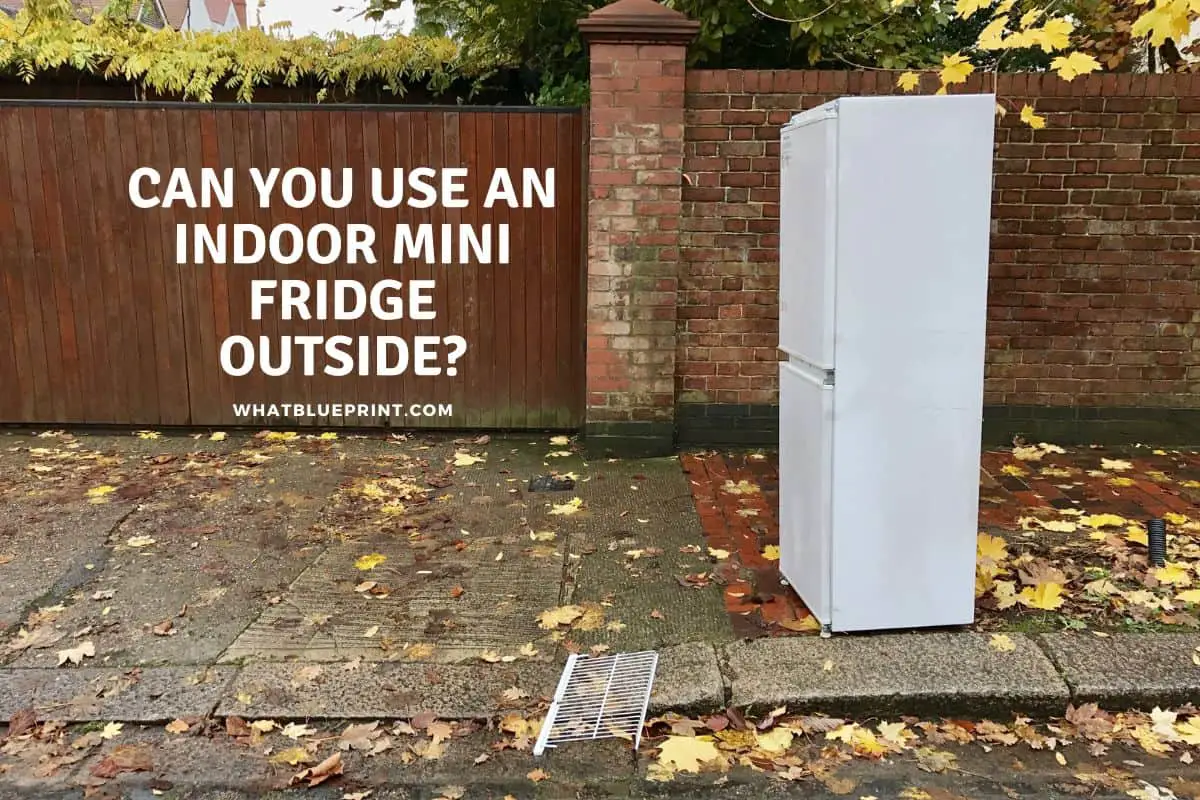Can You Use An Indoor Mini Fridge Outside?
You’ve organized a garden party, and the weather is perfect, but you need to have your food and drinks fresh, cold and on hand to keep the good vibes flowing. Can you use your indoor mini fridge outside for this purpose?
You can use an indoor mini fridge outside, preferably for a maximum of a few hours, as they are manufactured mainly for indoor use. When using your fridge, plug it into a safe electrical outlet, keep it out of direct sunlight, and turn it off when not in use.
Easy access to food and beverages at your outdoor event allows you the freedom to be with your guests without running back and forth catering. There is great appeal to having an outdoor fridge, but can you safely use your indoor mini fridge outside?
Is It Possible To Use An Indoor Mini Fridge Outside?
You can use your mini fridge outside to ensure chilled food and beverages are close at hand. It’s an easy set-up and doesn’t require much electricity. A generator isn’t needed to run a fridge for 6 – 8 hours. A safe and dry electrical outlet is sufficient. There is no harm in carefully unplugging a mini fridge, moving it around, and plugging it in somewhere else.
The compact size of a mini fridge makes it an appealing option to utilize in different spaces. If an extension cord is required to connect the fridge outside, fasten it with electrical tape so it doesn’t become a tripping hazard. Ensure the cable is not damaged and harmful to young children and animals.
The environment’s temperature will affect the fridge’s running, so keep it out of direct sunlight, preferably under cover and on a stable, dry surface with adequate airflow. If the mini fridge experiences extreme outdoor temperatures for an extended amount of time, it will result in the appliance not working correctly. There is a chance that the freshness of stored food in the fridge will be affected.
If the mini fridge is subject to heat, the interior temperature will likely increase and cause damage to the insulation seals and gasket. On the other hand, if temperatures drop below the set degrees of the refrigerator, the compressor will slow down, and it may switch itself off or stop working altogether.
If you use a fridge outdoors frequently, purchase an appliance designed for this purpose. The fridge will perform better. But what is the difference between an indoor mini fridge and one designed for outdoor use?
Why An Indoor Mini Fridge Differs From An Outdoor Fridge
Although an indoor mini fridge can be used outside under the right conditions and for a short time, it’s best to purchase an outdoor fridge for prolonged use. What differentiates an indoor mini fridge from its outdoor equivalent?
Mini Indoor Fridges Have A Lower Range Of Temperature
Mini indoor fridges use less power when stored in places with temperate and consistent conditions. The average temperature range for an indoor fridge is between 55 and 80 degrees Fahrenheit.
An outdoor fridge operates in fluctuating temperatures and more extreme conditions. Therefore, it has a more extensive temperature range which can be as low as 40 degrees or as high as 100 degrees Fahrenheit.

Mini Indoor Fridges Use Less Durable Materials
The inside cabinet of an indoor fridge is plastic or, in some cases, sheet metal, as these components are subject to less wear and tear. An outdoor fridge cabinet uses stainless steel with a higher food grade.
Outdoor fridges are more robust, with the outer cabinet made from 304-grade stainless steel. This steel is less prone to rust and corrosion due to a higher nickel and chromium content.
Insulation is a critical component of a fridge, and most manufacturers use polyurethane foam. Outdoor fridges require additional protection to effectively keep the contents of the refrigerator cool, lessening the damage from exposure to the elements.
Outdoor fridges maintain lower moisture levels by using more substantial quality materials for insulation. It is not uncommon to use extruded polystyrene instead of polyfoam. Additionally, the appliances have bearing and door seals, making temperature control more effective.
Outdoor fridges use higher-grade materials designed for more durability. The cooling system, comprising a compressor, condenser, evaporator, and filter, is made from materials such as aluminium, copper, or alloys and various forms of plastic. All this results in higher purchasing prices for outdoor refrigerators.
Mini Indoor Fridges Are Less Expensive
When it comes to refrigeration, the cost is always a huge factor. Unless you frequently use a fridge outdoors, the price will play a big part in deciding whether to purchase an outdoor fridge or not.
Mini indoor fridges range in price from as low as $89 and are generally less than $400 for a high-quality model. In comparison, outdoor fridge prices range from around $300 at the lowest and can cost over $1000 for a top-of-the-range brand.
This price variation is primarily because of the additional and more complex materials used to manufacture and design an outdoor fridge’s components. There are cost-effective cooling alternatives if purchasing an outdoor fridge is not affordable and you’d rather keep your mini fridge indoors.
Outdoor Options To Use Instead Of An Indoor Mini Fridge
Keeping your food and drinks cool outside without using your indoor mini fridge is possible. Some of the old-school methods are still effective, and there are technological advancements that make life easier.
A classic cooler box with ice blocks works for keeping beverages cold. Keep the ice box out of the sun and add salt to the water before freezing it into cubes to keep your drinks cooler for longer.
A portable refrigerator for food and drinks that works off an outside electrical source or car engine is a popular addition to any camping trip or outdoor party. These devices are readily available and affordable.
Propane gas fridges are a further exploration option as they are more efficient and convenient than mini indoor fridges. They are manufactured using no moving parts, require very little maintenance, and are ideal for outdoor use.
Maintenance Of Indoor Mini Fridge Outdoors
The manufacture of indoor mini-fridges doesn’t include components to protect against outdoor weather elements, so don’t keep your fridge outside all year long. If you use it for a short period, position it in a safe, cool, preferably covered space with an electrical source nearby. Keep the area dry to avoid rust or electrical hazards.
If the outdoor temperatures are not extreme and the fridge works optimally, storing food and beverages shouldn’t be a problem. However, if you are experiencing a heatwave, storing food, especially meat, for extended periods is not recommended.
Conclusion
The continued use of an indoor mini fridge outside is not advisable. If you have no other option and want easy access to food and drink at an outdoor event, ensure that you follow all safety precautions. Adhere to guidelines regarding temperature, electrical connections, and suitable airflow. When the party is over, safely unplug the mini fridge and restore it to its rightful place indoors.
References
- https://www.walmart.com/browse/home/mini-fridges-compact-refrigerators/4044_90548_9963786_8103923
- https://www.popularmechanics.com/home/a14325/refrigerator-taken-apart/
- https://www.newair.com/blogs/learn/indoor-beverage-fridge-vs-outdoor-beverage-fridge-
- https://homeguides.sfgate.com/run-refrigerator-outside-










